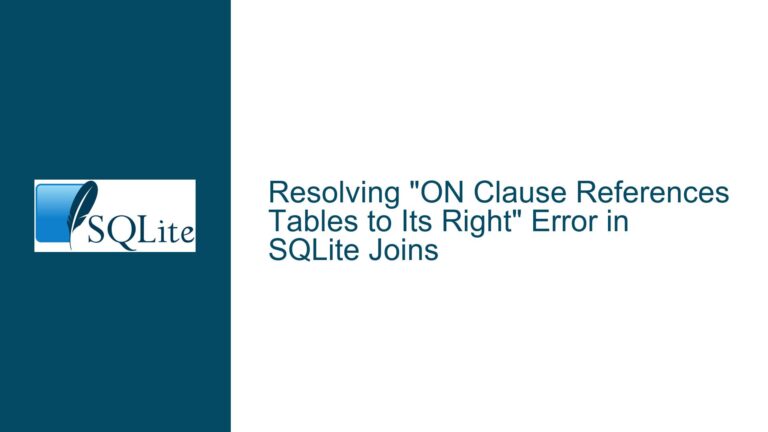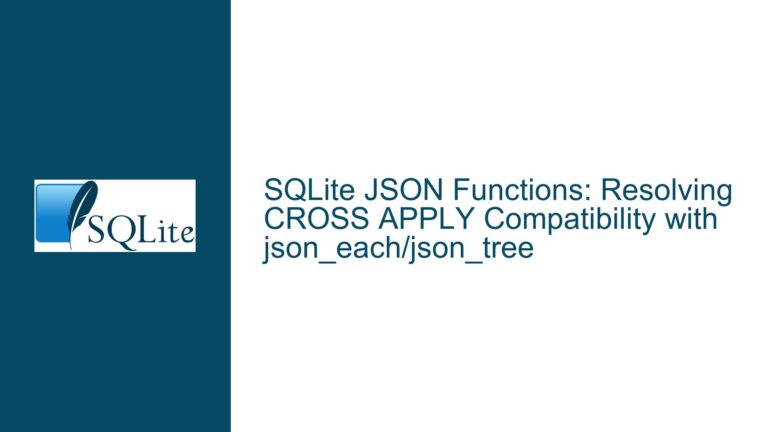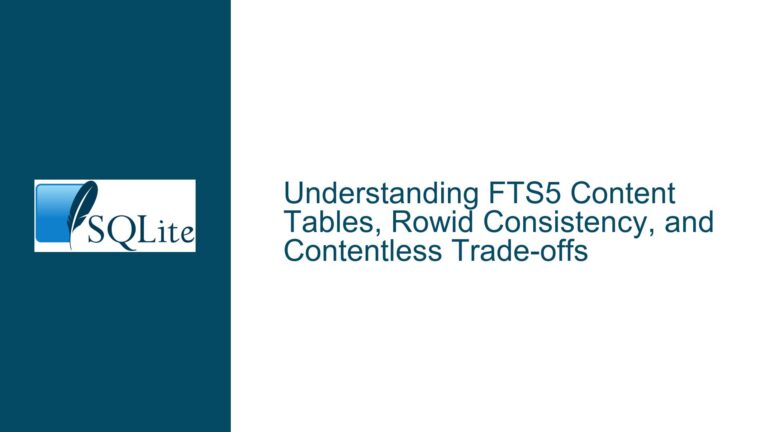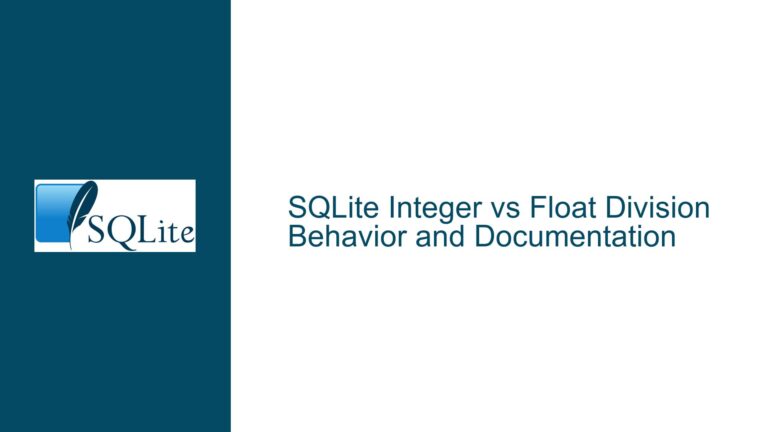SQLite Column DataType Issues in DataAdapter.Fill Operations
Issue Overview: Column DataType Mismatch in DataAdapter.Fill
When working with SQLite in conjunction with .NET’s DataAdapter.Fill method, a common issue arises where the data type of a dynamically generated column (such as a calculated or constant column) is not inferred correctly. In the provided scenario, the query SELECT RowState, 0 AS click FROM abc results in the click column being interpreted as an object type in the resulting DataTable schema, rather than the expected Int64 or Int32 type. This behavior can lead to confusion and potential issues in applications that rely on strongly-typed data, especially when integrating SQLite with other databases like MS SQL Server.
The root of this issue lies in SQLite’s dynamic type system and how it interacts with the .NET data provider. SQLite does not enforce strict data types on columns, and when a column is generated as part of a query (e.g., a constant or expression), it does not have a declared data type. This lack of explicit typing causes the .NET data provider to default to the object type when constructing the DataTable schema.
Possible Causes: SQLite’s Dynamic Typing and .NET Data Provider Behavior
The primary cause of this issue is SQLite’s type affinity system, which differs significantly from the strict typing systems found in other databases like MS SQL Server. In SQLite, columns can store values of any type, and the type of a value is associated with the value itself, not the column. This flexibility is one of SQLite’s strengths but can lead to unexpected behavior when interfacing with systems that expect strict typing.
When a query includes a constant or expression, such as 0 AS click, SQLite does not assign a specific data type to the resulting column. Instead, the column is treated as having no declared type. This is because SQLite’s type system does not enforce types on expressions or constants. The .NET data provider, when populating the DataTable, encounters this lack of type information and defaults to using the object type for the column.
Another contributing factor is the behavior of the DataAdapter.Fill method itself. This method relies on the schema information provided by the database to construct the DataTable. When the schema does not include explicit type information for a column, the DataAdapter has no basis for inferring the correct type and falls back to the most generic type, which is object.
Additionally, the integration of SQLite with MS SQL Server in the same application can exacerbate this issue. MS SQL Server uses a strict typing system, and columns in queries are expected to have well-defined data types. When data is transferred between SQLite and MS SQL Server, the mismatch in type handling can lead to inconsistencies and errors if not managed carefully.
Troubleshooting Steps, Solutions & Fixes: Ensuring Correct DataType Inference
To address the issue of incorrect data type inference in DataAdapter.Fill, several strategies can be employed. These strategies range from modifying the query to explicitly define types, to handling the issue programmatically in the .NET code.
1. Explicitly Define Column Types in SQL Queries
One approach is to ensure that the SQL query explicitly defines the data type for any calculated or constant columns. While SQLite does not enforce types, the .NET data provider can use type hints to infer the correct type. For example, the query can be modified to cast the constant value to a specific type:
SELECT RowState, CAST(0 AS INTEGER) AS click FROM abc
By using the CAST function, the click column is explicitly defined as an INTEGER, which the .NET data provider can then interpret correctly. This approach ensures that the DataTable schema reflects the intended data type.
2. Modify the DataTable Schema Programmatically
If modifying the SQL query is not feasible, the DataTable schema can be adjusted programmatically after the DataAdapter.Fill operation. This involves iterating through the columns of the DataTable and setting the appropriate data type for any columns that were incorrectly inferred as object.
DataTable dataTable = new DataTable();
using (SQLiteConnection connection = new SQLiteConnection("YourConnectionString"))
{
connection.Open();
using (SQLiteDataAdapter adapter = new SQLiteDataAdapter("SELECT RowState, 0 AS click FROM abc", connection))
{
adapter.Fill(dataTable);
}
}
// Adjust the schema for the 'click' column
if (dataTable.Columns.Contains("click"))
{
dataTable.Columns["click"].DataType = typeof(int);
}
This approach ensures that the click column is treated as an integer in subsequent operations, even if it was initially inferred as an object.
3. Use Strongly-Typed DataSets
Another solution is to use strongly-typed DataSets in .NET. A strongly-typed DataSet provides a schema that defines the data types of each column, eliminating the need for runtime type inference. This approach requires defining the DataSet schema in advance, either through a visual designer or by manually creating the schema in code.
// Define the schema for the DataSet
DataSet dataSet = new DataSet();
DataTable table = new DataTable("abc");
table.Columns.Add("RowState", typeof(string));
table.Columns.Add("click", typeof(int));
dataSet.Tables.Add(table);
// Fill the DataSet using the DataAdapter
using (SQLiteConnection connection = new SQLiteConnection("YourConnectionString"))
{
connection.Open();
using (SQLiteDataAdapter adapter = new SQLiteDataAdapter("SELECT RowState, 0 AS click FROM abc", connection))
{
adapter.Fill(dataSet, "abc");
}
}
By using a strongly-typed DataSet, the click column is guaranteed to be treated as an integer, regardless of how SQLite handles the type information.
4. Implement Custom Data Adapter Logic
For more complex scenarios, it may be necessary to implement custom logic in the data adapter to handle type inference. This can be done by subclassing the SQLiteDataAdapter and overriding the Fill method to adjust the schema before populating the DataTable.
public class CustomSQLiteDataAdapter : SQLiteDataAdapter
{
public CustomSQLiteDataAdapter(string selectCommand, SQLiteConnection connection)
: base(selectCommand, connection) { }
public override int Fill(DataTable dataTable)
{
int result = base.Fill(dataTable);
// Adjust the schema for the 'click' column
if (dataTable.Columns.Contains("click"))
{
dataTable.Columns["click"].DataType = typeof(int);
}
return result;
}
}
// Usage
DataTable dataTable = new DataTable();
using (SQLiteConnection connection = new SQLiteConnection("YourConnectionString"))
{
connection.Open();
using (CustomSQLiteDataAdapter adapter = new CustomSQLiteDataAdapter("SELECT RowState, 0 AS click FROM abc", connection))
{
adapter.Fill(dataTable);
}
}
This approach provides a reusable solution for ensuring correct type inference across multiple queries and DataTable instances.
5. Leverage SQLite’s Type Affinity System
Understanding SQLite’s type affinity system can also help in resolving type inference issues. SQLite assigns a type affinity to each column based on its declared type, which influences how values are stored and retrieved. By aligning the query with SQLite’s type affinity rules, it is possible to influence the .NET data provider’s type inference.
For example, if the click column is intended to store integers, the query can be written to align with SQLite’s INTEGER affinity:
SELECT RowState, 0 AS click FROM abc WHERE click IS NOT NULL
While this does not directly solve the type inference issue, it ensures that the click column is treated as an integer within SQLite, which can help the .NET data provider infer the correct type.
6. Use Third-Party Libraries or Extensions
There are third-party libraries and extensions available that provide enhanced type handling and schema management for SQLite in .NET. These libraries often include features for automatically inferring and adjusting data types, reducing the need for manual intervention.
For example, the System.Data.SQLite library provides additional functionality for working with SQLite in .NET, including improved type handling and schema management. By leveraging such libraries, it is possible to streamline the process of ensuring correct type inference in DataAdapter.Fill operations.
7. Debugging and Logging
Finally, implementing robust debugging and logging can help identify and resolve type inference issues more effectively. By logging the schema information and data types before and after the DataAdapter.Fill operation, it is possible to pinpoint where the type inference is failing and take corrective action.
DataTable dataTable = new DataTable();
using (SQLiteConnection connection = new SQLiteConnection("YourConnectionString"))
{
connection.Open();
using (SQLiteDataAdapter adapter = new SQLiteDataAdapter("SELECT RowState, 0 AS click FROM abc", connection))
{
adapter.Fill(dataTable);
}
}
// Log the schema information
foreach (DataColumn column in dataTable.Columns)
{
Console.WriteLine($"Column: {column.ColumnName}, Type: {column.DataType}");
}
// Adjust the schema for the 'click' column
if (dataTable.Columns.Contains("click"))
{
dataTable.Columns["click"].DataType = typeof(int);
}
// Log the adjusted schema information
foreach (DataColumn column in dataTable.Columns)
{
Console.WriteLine($"Column: {column.ColumnName}, Type: {column.DataType}");
}
By incorporating logging into the data access layer, it becomes easier to diagnose and resolve type inference issues as they arise.
Conclusion
The issue of incorrect data type inference in DataAdapter.Fill operations when working with SQLite is a common challenge, particularly when integrating SQLite with other databases like MS SQL Server. This issue stems from SQLite’s dynamic type system and the .NET data provider’s reliance on schema information for type inference. By understanding the underlying causes and employing the strategies outlined above, it is possible to ensure that the DataTable schema accurately reflects the intended data types, thereby avoiding potential issues in the application.
Whether through modifying the SQL query, adjusting the DataTable schema programmatically, using strongly-typed DataSets, implementing custom data adapter logic, leveraging SQLite’s type affinity system, utilizing third-party libraries, or incorporating debugging and logging, there are multiple approaches to resolving this issue. The choice of strategy will depend on the specific requirements and constraints of the application, but with careful consideration and implementation, it is possible to achieve seamless integration and accurate type handling when working with SQLite in .NET.






